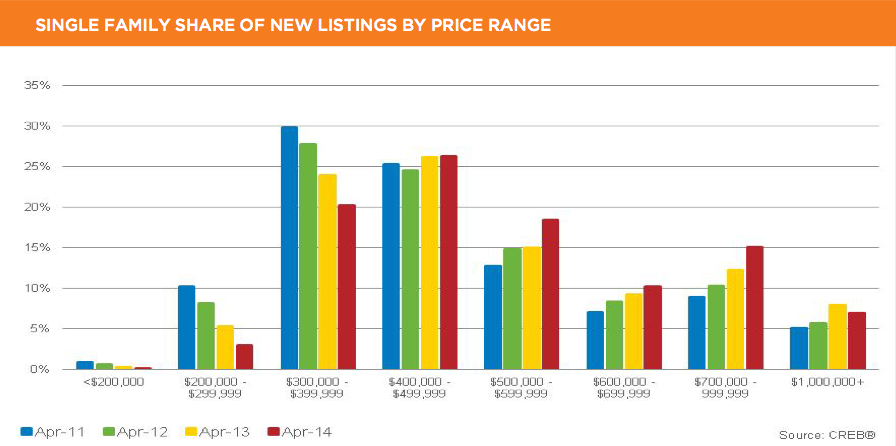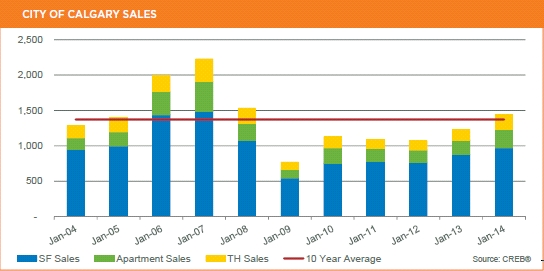Housing supply improves in June
Condominium apartment benchmark price surpasses previous highs
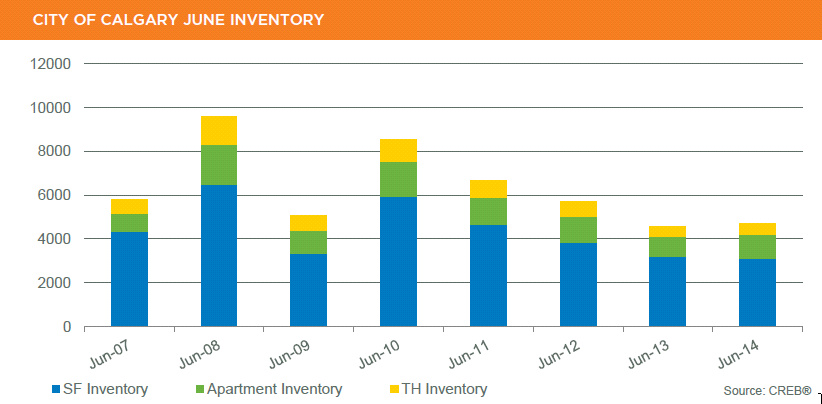 click on the link or image above for the full CALGARY REGIONAL HOUSING MARKET STATISTICS for June 2014
click on the link or image above for the full CALGARY REGIONAL HOUSING MARKET STATISTICS for June 2014
Residential sales and listings in Calgary increased by double-digit rates in June compared to the same time last year. This increase is partly due to the floods impacting housing activity throughout the second half of June 2013.
“Last June was not a normal month, so it’s difficult to compare the two,” said CREB® president Bill Kirk. “The historic floods of 2013 forced residents and business owners from their homes and places of work. It’s not surprising that many Calgarians were not focused on purchasing or listing their home at that time.”
Despite the unusual circumstances of last year, the housing market continues to demonstrate strong demand. Residential sales totaled 2,670 units this June, which was 18 per cent above the 10-year average. Total sales for the first half of 2014 increased to 13,929 from 12,257 in 2013.
New listings totaled 3,814 units in June, representing the first time since June 2010 that it outpaced the long-term average. The monthly influx of new listings also helped ease some of the tightness in the market by improving inventory levels, which totaled 4,726 units compared to 4,584 in June 2013.
“Economic conditions continue to support housing demand growth. However, improving supply should help push our market toward more balanced conditions,” said CREB® chief economist Ann-Marie Lurie. “Over time, this will cause price growth to ease from its current levels.”
Single-family unadjusted benchmark prices totaled $509,700 in June, a one per cent increase over the previous month, and a 10.9 per cent increase over June 2013.
Single-family sales for June totaled 1,769 units, which outpaced the 10-year average by 10 per cent. The rise in sales activity was largely due to improved new listings. While this helped ease some of the tightness in this market, supply levels continue to fall in this sector.
The boost in single-family new listings for June was largely due to an increase in units listed at more than $500,000 – rising to 1,359 units in June from 954 the year prior.
“With less resale single-family product available in the lower price ranges citywide, this market continues to be fairly competitive,” said Kirk. “However, for consumers looking in the higher price ranges, there is often more choice.”
Condominium apartment sales for the first half of 2014, totaled 2,494 units, compared with 2,027 during the same period a year prior. While new listings growth kept pace with sales activity during the first part of the year, it has exceeded sales growth over the past two months, pushing up inventory levels and moving this market into more balanced conditions.
Apartment-style benchmark prices totaled $299,700 in June, a new high in the condominium apartment sector and 13.5 per cent increase over the previous year. Meanwhile, the benchmark price for townhouse-style units reached $326,000, still shy of previous records.
“As citywide condominium apartment prices have finally recovered from 2007 highs, we would expect this will continue to encourage some listings growth,” said Lurie. “However, as this market has moved into more balanced conditions, and if inventories continue to rise, price growth should ease throughout the remainder of the year.”
luxury real estate
Cottages, Camps, Cabins and Condos – RE/MAX report sees sunny skies ahead for recreational property sales in Canada

Today RE/MAX released its annual Recreational Property Report, showing healthy activity across much of the country and forecasts modest increases in sales and prices through the rest of the year. With schools out and the coming Canada Day long weekend marking the unofficial start of summer, national recreational property sales and listings have rebounded from a slow start caused by the late spring and cold winter experienced in many markets throughout the country.
National Trends: While there are nuances and specific attractions that define local markets across the country, a number of broad national trends have been observed.
Buyer Profiles: Two groups of buyers are driving the majority of recreational properties sales in Canada. The first is made up of families with younger children, who have built up equity in their primary residence and are using that money to purchase a vacation property. The second group is made up of near or recent retirees who have purchased a recreational property with a plan to use it as a primary summer residence and launching pad for winter travel.
Residential Spillover: Canada’s hot residential real estate market in urban centres has had a spillover effect on recreational property sales. This is particularly true in markets within a two-hour drive of the country’s large urban centres, where price appreciation has allowed homeowners to use equity gains in their primary residence to purchase a second home for recreational use.
Evolving Use: The way buyers are using their recreational properties is changing. While in the past, properties were largely used for weekend getaways and a week or two of summer vacationing, today many are purchasing a property from which they can work throughout the summer. Furthermore, a majority now see their recreational property as a four-season vacation option, rather than just a summer retreat.
CMHC Insurance Changes: While some potential recreational buyers may have been discouraged by the Canada Mortgage and Housing Corporation’s recent decision to eliminate insurance on second mortgages, little to no material impact has been witnessed from this change. There are many options available for financing and insuring mortgages on a second property and an experienced RE/MAX agent can help buyers find the option that best meets their specific needs.
Read more: 2014 Recreational Property National Press Release
The full RE/MAX Recreational Property Report, with market activity summaries for 41 regions across the country, is available at: http://rem.ax/1lNuH73.
Videos summarizing markets in the Ontario and Atlantic Regions can be found here: http://rem.ax/1lNyFfV and summarizing Western Canada regions can be found here: http://rem.ax/1lOV6TC.
Sales improve as consumers have more choice
Click Here for the full .pdf of the CALGARY REGIONAL HOUSING MARKET STATISTICS.
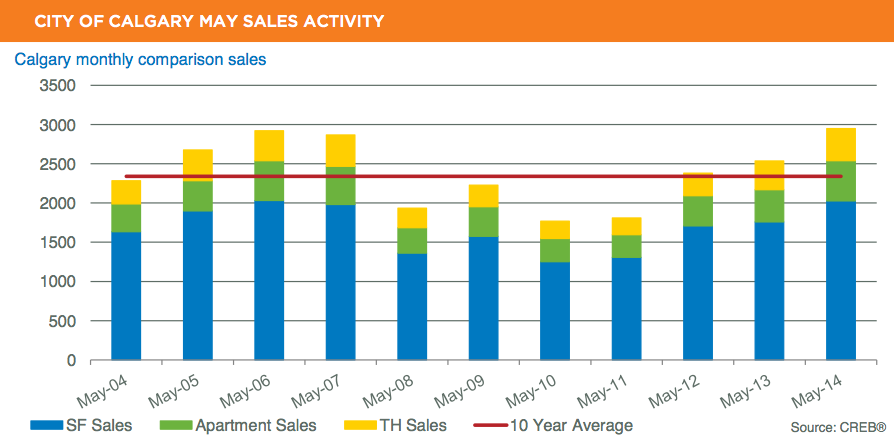
Residential sales in the city of Calgary totaled 2,948 units in May, a 16 per cent increase over the previous year.
Sales last month were well above long-term trends and are the highest May activity on record.
“Strong sales activity is a reflection of improving fundamental conditions such as a growing population, favourable lending rates and rising wages,” says CREB® chief economist Ann-Marie Lurie. “Leading up to May, resale market sales were somewhat restricted by lack of choice.
However, recent price gains have encouraged growth in new listings, helping meet some of the housing demand.”
In May, new listings totaled 4,327, a 16.5 per cent rise over figures reported during the same time last year with gains in new listings nearly matching sales growth. While inventories remain nearly five per cent below levels recorded last year, this is the first time in over two years that year-over-year declines were not in the double digits.
While market conditions continue to favour the seller, improving supply has helped ease some of the tightness in the market.
“Market conditions vary depending on the product type,” says CREB® president Bill Kirk.
“Both condominium apartment and townhouse style products have recorded inventory growth relative to last year.
This is good news for consumers looking for more choice in condominiums priced between $200,000 and $400,000.” Year-to-date condominium apartment sales have totaled 2,020 units, a 21 per cent increase over the first five months of 2013.
Meanwhile, the recent boost in new listings caused inventory levels to rise to 1,051 units, a 13.1 per cent increase compared to last year, representing 23.3 per cent of all city-wide inventories.
Click Here for the full .pdf of the CALGARY REGIONAL HOUSING MARKET STATISTICS.
CALGARY REGIONAL HOUSING MARKET STATISTICS for April 2014
Price gains encouraging new listings
New listings improve for all product types in the city
Following a slow start to the year, improved weather and price gains supported new listings growth. New residential listings in April totaled 3,754 units, an eight per cent increase over the previous year. Meanwhile sales activity totaled 2,545 units for the month, a seven per cent increase over April 2013.
“Throughout 2014, the condominium apartment market has recorded new listing gains, while until April, the single-family sector saw a reduction in new listings,” says CREB® president Bill Kirk. “Many single-family homeowners have been waiting for further price gains and the start of the spring market to list their homes.”
Single-family sales in April totalled 1,736 units, representing a year-over-year gain of eight per cent and a year-to-date increase of nine per cent. Meanwhile, single-family new listings totalled 2,584 units in April, a 7.4 per cent increase over April 2013.
As new listing growth outpaced sales growth, inventory levels improved, easing some of the tightness in the market. However, it was not enough to push the market back into balance.
“While we did anticipate the rise in new listings this spring, certain segments of the market will likely remain tight,” says CREB® Chief Economist Ann-Marie Lurie. “The single-family market continues to record declining listings for product priced below $400,000. Meanwhile, the growth in listings in April was mostly due to gains in the $500,000 – $999,999 range.”
Condominium apartment sales totaled 449 units in April, for a year-to-date total of 1,511. April’s year-over-year sales growth of 4.7 per cent was outpaced by the 11.2 per cent rise in new listings. This resulted in a rise in inventory levels to 898 units, three per cent higher than levels recorded in 2013. It’s also the only sector within the city limits to record annual growth in inventory availability. This growth is in part related to more new home product becoming available.
“Improved selection in the market is welcome news,” says Kirk. “Many consumers are interested in entering the market but the lack of choice poses challenges. While we are still early in the season, if this trend continues, it should provide more opportunities for consumers who have been unsuccessful with finding properties.”
Price gains continued across all property types this month. The unadjusted single-family benchmark price totaled $496,700 in April, a 9.67 per cent increase over April 2013 and up 1.24 per cent over March figures. While the price gains are still higher than expected, the pace of growth has slightly eased.
Meanwhile, unadjusted benchmark prices for condominium apartment and townhouse properties totalled a respective $291,700 and $316,700 in April. Despite the year-over-year price gains of 11.6 per cent for apartments and 9.6 per cent for condominiums, prices continue to remain just shy of peak levels recorded in 2007.
“Gains in employment and net migration have supported demand growth in the housing sector,” says Lurie. However, with unadjusted prices only recently recovering in some sectors, it is not a surprise that resale supply has not kept pace. As prices continue to improve and lending rates remain low, this should help support further gains in new listings, easing some of the tightness in the market.”
Click Here to view the full .pdf with more graphs and information!
RE/MAX Spring Market Trends Report – 2014

Despite record setting low temperatures and snow storms, housing market activity in Canada during the first quarter of 2014 showed year-over-year resilience in most regions, with some exceptions in atlantic Canada, Manitoba and Ontario. In urban centres, house prices continued to post gains, in large part due to a lack of inventory; price increases were also seen in regions with strong local economies driven by the resource sector and major infrastructure development.
Potential homebuyers in Toronto and Calgary continue to be frustrated by low inventory and low affordability. In Toronto, where inventory has reached a record low, average residential sale prices increased almost 8 per cent year-over-year in march. RE/MAX is predicting a similar increase throughout the remainder of 2014. In Calgary, where a typical home spent only 34 days on the market, inventory levels were 30 per cent below the threshold of a balanced market. House prices in the region increased by over 5 per cent compared to the same period last year.
Vancouver’s balanced market posted a more modest year-over- year gain, but the average selling price of $1.36 million for a single family house has priced many buyers out of the market. Low affordability in this desirable city has prompted some innovative solutions, where we are seeing entire new lines of multipurpose furniture developed for 400 square foot studios that are selling in the $150,000 price range.
Many potential first-time buyers in Calgary and toronto have decided that purchasing a home is now more attractive given the reality of rising rents and a lack of rental selection. Both cities have extremely low vacancy rates with Toronto posting a rate below two per cent and Calgary’s renters struggling with a rate of one per cent. in both markets desirable rental properties are now attracting multiple offers, creating additional frustrations for those waiting to buy.
Harsh winter conditions and power outages delayed market activity across most of Canada, but were most notable in atlantic Canada as well as parts of southern Ontario. Looking ahead, spring sales in these regions are expected to make up for the lack of activity seen during the first two months of the year as new listings help satisfy pent-up buyer demand. For example, despite consumer confidence and a strong local economy, sales in St. John’s decreased 9 per cent year-over-year in February as they experienced one of the harshest winters on record. Southern ontario also suffered from snow storms and power outages. in Windsor, which suffered its heaviest snowfall winter since 1908, total first quarter unit sales declined 15 per cent year-over-year. However, march showed signs of recovery as unit sales were only modestly down one per cent year-over-year. This scenario is being played out in many of the markets that experienced a difficult winter.
Natural resources will continue to play a crucial role in fueling the Canadian housing market in 2014, specifically in Calgary, Saskatoon and St. John’s. in new Brunswick, Saint John buyers are waiting on announcements about pipeline and oil refinery developments that could have a transformative impact on their market.
Foreign buyers looking for investment properties or second homes have been drawn to Canadian cities for a number of years due to close social and economic ties as well as confidence in Canadian real estate. more recently, a weakened Canadian dollar has created another incentive for those buyers to invest in Canada. as the country shakes off the harsh winter, markets across Canada should see healthy activity through the remainder of 2014.
Click Here to view the full .pdf report!
2014 RE/MAX Spring Market Trends Report
Calgary housing market prices reach all-time record high.
March MLS sales set new standards as inventory remains low
A continued low inventory of listings combined with strong homebuyer demand pushed prices in Calgary’s resale housing market to all-time highs again in March.
Calgary Real Estate Board statistics released Tuesday indicated MLS records, for any month, were set for average sale prices and median prices in the overall city residential market as well as in the single-family category.
In the city, the overall average sale price in March was $484,918, up 5.18 per cent from last year, while the median price was rose by 6.90 per cent to $430,800. For the single-family market, the average sale price climbed by 7.32 per cent to $556,402 and the median price was up by 8.89 per cent to $490,000.
March registered 2,485 sales in the city which was the highest March total since 2007. Sales were up 17.94 per cent from last year.
“The amount of inventory is quite low in most communities within Calgary and demand remains high. Buyers are having to make extremely quick decisions as there is a high likelihood they will be in a multiple offer situation,” said Tanya Eklund, a realtor with RE/MAX Real Estate (Central). “Trying to find land to build on is one of the tightest markets right now due to the amount of new builders that have come into the inner city.
“Calgary real estate as a whole is not as tight as it was in 2006, however we are seeing homes in many areas of the city sell over list or close to list price. I do not have a crystal ball but I do suspect our market will remain strong into the second quarter of the year. My hope is the gap between supply and demand will become less. Having more supply, which statistically we do in the spring market, will give buyers more selection to choose from and not have to make same day decisions.”
The March record prices eclipsed the previous records set in February which were: $482,745 average sale and $424,900 median for the overall city; and $550,376 average sale and $480,000 median for single-family homes.
March was the 26 consecutive month of year-over-year average sale price growth and the 12th consecutive month of annual sales growth.
At the end of March, active listings in the city were down 19.35 per cent to 3,231 compared with last year. There were 3,319 new listings in the month, up 3.98 per cent from a year ago.
According to Mike Fotiou, associate broker with First Place Realty, the month also was a record one for luxury home sales with 79 properties selling for $1 million or more. That’s up from the previous record of 74 set last year and just four shy of the all-time monthly record of 83 which was established in May of last year.
Also, the first three months of this year set a record for most luxury sales in a first quarter of a year at 186, up from 171 for the same period last year.
“There seems to be a lot of positive buzz with Calgary’s economic state,” said Eklund. “With an unemployment rate of 4.8 per cent, under 1.5 per cent (rental) vacancy and record migration into the city, it appears that Calgary is a prime city to work and live. All of these factors contribute to our current strength in the Calgary real estate market and why sales are increasingly strong.
Single-family home sales rose by 14.87 per cent in March to 1,699 MLS transactions.
In the condo apartment category, sales of 445 were up 28.61 per cent from last year. The median price rose by 10.04 per cent to $285,000 while the average sale price was up by 3.22 per cent to $311,075.
In the condo townhouse sector, sales were up 20.92 per cent from last year to 341 units while the median price rose by 7.33 per cent to $323,000. However, the average sale price was down by 0.04 per cent to $355,617.
The towns surrounding Calgary saw sales spike by 35.71 per cent to 494 transactions. The median price increased by 9.19 per cent to $383,250 while the average sale price was up by 7.63 per cent to $392,572.
Jim Dewald, dean of the Haskayne School of Business at the University of Calgary, said so much of real estate is driven by the perception that the market is tightening or that prices are going up.
“There’s so much speculation always built into housing,” he said. “And there seems to be a feeling right now that inventories will only continue to tighten which will push prices up and now it’s more affordable than ever because mortgages are even going lower which is shocking to most people. I think there’s so much pressure because there’s a sense that prices are going to go up, get in there now.”
But Dewald cautioned that he is not seeing the foundational statistics in terms of employment growth that would sustain the “kind of anxiety that’s out there.” He also said inventories could change the market conditions.
“I don’t know if it’s wise to anticipate that prices will continue to go up because the supply side could change in the next few months,” said Dewald.
Average Price of single family homes in Calgary:
 By Mario Toneguzzi, Calgary Herald
By Mario Toneguzzi, Calgary Herald
CALGARY REGIONAL HOUSING MARKET STATISTICS: Conditions continue to favour the seller…
New listings remain below expectations in the single family sector…

Click here or on the above photo to download a .pdf of the Calgary Regional Housing Market Statistics for March 2014
Residential sales activity improved across all sectors in March. However, declining new listings in the single family sector combined with further gains in sales activity decreased single family inventory to the lowest March level since 2006.
“There are several factors contributing to the growth in housing demand, including the inflow of people to our province over the past two years, strong gains in employment and tight rental conditions,” says CREB® chief economist Ann-Marie Lurie. “However, supply conditions vary amongst the different property segments, impacting the number of sales and price growth. If supply constraints persist in the single family sector, prices are expected to record further gains as we move into the spring market.”
Single family sales at the end of the first quarter totalled 3,901 units, a 9.5 per cent increase over the same period last year. Meanwhile, the amount of new listings declined by nearly five per cent. As sales growth outpaced the amount of new listings growth in the market, inventory levels dropped to just over 2,000 units.
Persistently tight market conditions prevented any relief in terms of price gains. The unadjusted single family benchmark price totalled $490,600 in March, a 9.9 per cent increase over the previous year and monthly increase of 1.6 per cent.
“With tight market conditions, particularly in the single family market, purchasers should ensure they have a clear understanding of what they can afford and what they are willing to pay for a home,” says Bill Kirk, CREB® president. “However, both sellers and buyers need to be aware that conditions are dependent on the community and price range that you are targeting.”
Condominium apartment sales totalled 1,062 after the first quarter. Sales growth was strongest in this sector due to the availability of listings. New listings after the first quarter totalled 1,722, an 18 per cent increase over the previous year. While demand continued to outpace listing growth, keeping market conditions relatively tight, inventory levels are similar to the previous year.
“Nearly 50 per cent of new listings in the apartment sector are priced in the range of $200,000 – $299,999, providing options for those looking for affordable product,” says Kirk. “However, there are far fewer options for those looking to spend less than $200,000. After the first quarter, apartment product priced below $200,000 has dropped from over 16 per cent of the market last year to 6.4 per cent.”
Condominium apartment and townhouse prices totalled a respective $287,200 and $313,100. Condominium apartment price recorded a year-over-year increase of 11.5 per cent and are the highest relative to the townhouse and single family sector. Despite strong price gains across all sectors, overall the condominium sector continues to record price levels below peak records.
“Some easing of the supply pressure in the condominium market is expected as new construction projects are completed,” says Lurie. “However, thanks to Calgary’s strong economy, it is expected that most new supply can be absorbed without risk of oversupply and condominium price correction.”
Click here to download a .pdf of the full report: Calgary Regional Housing Market Statistics for March 2014
CALGARY REGIONAL HOUSING MARKET STATISTICS – February 2014
Sales growth boosted by condominium activity
Lack of choice in single family sector impacts sale growth.
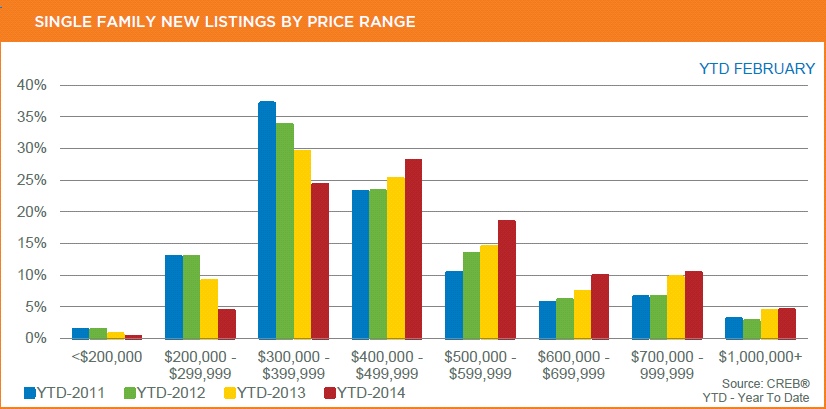
Click on the following link or on the photo above to view the .pdf of The CALGARY REGIONAL HOUSING MARKET STATISTICS for February 2014.
Following double digit gains last month, sales growth in the city of Calgary totaled 1,854 units, or an 8.68 per cent increase over the same period in 2013. Slower sales growth resulted in a reduction of listings in the single family sector. However, single family sales still totalled 1,230 units, a 1.9 per cent increase over the previous year.
“Demand growth in the single family sector has been restricted by the availability of product,” says CREB® Chief Economist Ann-Marie Lurie. “New listings in this sector fell for the second consecutive month, causing further tightening in an already undersupplied market.”
Despite the pull back in the single family sector, condominium sales continue to surge. After the first two months of the year, both condominium apartment and townhouse sales increased by 28 per cent compared to last year.
“Consumers who are in the market for single family homes priced below $300,000 do not have many options, and when product does become available, it typically does not stay on the market for long,” says CREB® President Bill Kirk. “However, nearly 54 per cent of the new condominium apartment listings this year are priced below $300,000, which is providing options for consumers looking for affordable product.”
The condominium market benefited from significant gains in new listings. Year-to-date, condominium apartment and townhouse listings improved by a respective 17 and 4 per cent for a combined total of 1,737 units.
“As we move into the spring market we expect that listings will improve in all sectors,” says Kirk. “The rise in listings will help ease some of the tightness in the market, with price growth impacts varying by community and property type.”
With no significant additions to the housing supply, resale prices continued to rise.
The unadjusted single family benchmark price totalled $482,800 in February, a 1.28 per cent increase over the previous month and a 9.1 per cent increase over the previous year.
Meanwhile, condominium apartment and townhouse prices totaled a respective $283,400 and $309,700. Condominium apartment price increases remain at double digit levels this month with a year-over-year gain of 12.4 per cent.
Despite the strong gains in condominium prices, overall benchmark prices in both the apartment and townhouse sector continue to remain below peak records set back in 2007.
“Resale market conditions have favoured the seller, and this has translated into price gains, which is strongest in the condominium sector,” says Lurie. “However, it is important to note that condominium prices have not yet risen above previous highs, whereas single family prices recovered last year.”
POSITIVE START TO THE NEW YEAR…
Sales activity and prices improve over 2013.
CALGARY REGIONAL HOUSING MARKET STATISTICS for January 2014
On the heels of a strong year of sales growth, January sales in the city of Calgary totaled 1,440 units, a 17 per cent increase over the previous year.
“Sales growth continues at the double digit pace seen over the later portion of 2013, mostly due to the gains in the condominium sector,” said CREB® chief economist Ann-Marie Lurie. “While these are the highest January sales levels since 2008, total sales transactions are in line with long-term trends.”
Condominium apartment and townhouse sales totaled 466 units in January, a 33 per cent increase over the same period in 2013. This is relative to the 974 sales in the single family sector, only a 11 per cent increase over the previous year.
“Consumers looking for more affordable product turned to Calgary’s condominium market, which was the only sector to record growth in new listings, compared to January 2013,” explained CREB® president Bill Kirk. “The improvement in listings helped ease some of the tightness in the condominium market, however overall conditions continue to favour the seller.”
New listings in the condominium apartment and townhouse market totaled 809 units, a combined increase of six percent. Meanwhile, the single family sector lost momentum significant change in the supply situation this month, prices continue to rise at higher than expected levels.”
To read the full article click on the following link: CALGARY REGIONAL HOUSING MARKET STATISTICS for January 2014
REAL ESTATE QUARTERLY STATISTICS…
Check out the number of resale homes sold and average sale price by district: REAL ESTATE QUARTERLY STATISTICS







